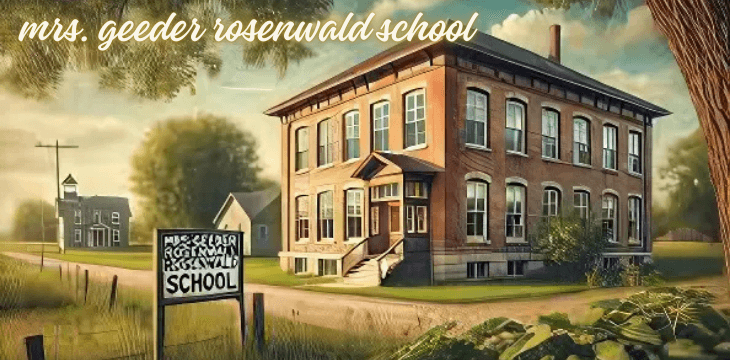In the early 20th century, the American South was a place where educational opportunities for African American children were as rare as hen’s teeth. Amidst this backdrop of segregation and inequality, the Rosenwald Schools emerged as beacons of hope. Among these institutions, the Mrs. Geeder Rosenwald School stands out as a shining example of what determination and community spirit can achieve. Let’s delve into the story of this remarkable school and the indomitable woman behind it.
Contents
The Genesis of mrs. geeder rosenwald school
Julius Rosenwald’s Vision
Julius Rosenwald, a philanthropist and part-owner of Sears, Roebuck and Company, had a vision: to bridge the educational gap for African American children in the segregated South. Partnering with Booker T. Washington, he initiated a program that led to the construction of over 5,000 schools between 1917 and 1932. These institutions, known as Rosenwald Schools, became lifelines for communities thirsting for knowledge.
Community Collaboration
The success of the Rosenwald initiative hinged on collaboration. Local African American communities were required to raise part of the funds, contributing land, labor, and money. This model fostered a sense of ownership and pride, as everyone had skin in the game. The Mrs. Geeder Rosenwald School was no exception, standing as a testament to what can be achieved when communities unite for a common cause.
Who Was Mrs. Geeder?
A Pillar of the Community mrs. geeder rosenwald school
Mrs. Geeder was more than just an educator; she was a beacon of hope. In an era when African American women faced double discrimination due to race and gender, she rose above, dedicating her life to teaching and uplifting her community. Her commitment to education and her students was unwavering, making her a revered figure in the annals of the Rosenwald Schools.
Overcoming Adversity
Operating in the Jim Crow South was no walk in the park. Mrs. Geeder faced systemic racism, inadequate funding, and societal indifference. Yet, she remained undeterred, turning challenges into opportunities. Her resilience not only inspired her students but also instilled in them a belief in their own potential.
A Day in the Life at Mrs. Geeder Rosenwald School
Morning Rituals mrs. geeder rosenwald school
Picture this: a crisp morning in the 1930s. Children, eager to learn, make their way to the modest yet dignified building that is the Mrs. Geeder Rosenwald School. The day begins with the Pledge of Allegiance, followed by a soulful rendition of “Lift Every Voice and Sing.” The atmosphere is charged with hope and determination.
The Learning Environment
Inside, the classrooms are bathed in natural light, thanks to large windows—a design feature of Rosenwald Schools to maximize illumination and ventilation. Despite limited resources, the walls are adorned with educational charts, and the chalkboards are filled with lessons of the day. Mrs. Geeder moves gracefully between groups, her presence commanding respect and admiration.
Beyond Academics
But it wasn’t all about the three Rs. Mrs. Geeder understood the importance of holistic education. Afternoons might be spent in vocational training—teaching skills like agriculture, carpentry, or homemaking. Evenings often saw the school transform into a community center, hosting adult literacy classes, meetings, and social events. The school was truly the heart of the community.
The Architectural Significance mrs. geeder rosenwald school
Standardized Yet Adaptable Design
Rosenwald Schools followed standardized designs that were both cost-effective and functional. Features like large windows ensured ample natural light, reducing the need for electricity. The layouts were simple, with multiple classrooms and central hallways, but adaptable to the specific needs of each community. This flexibility allowed schools like Mrs. Geeder’s to serve their students effectively, even in resource-limited settings.
The Impact on Students and the Community
Empowering the Next Generation mrs. geeder rosenwald school
The education provided at Mrs. Geeder Rosenwald School was transformative. Students left not just with academic knowledge but with a sense of purpose and self-worth. Many went on to become teachers, business leaders, and activists, carrying forward the lessons learned within those walls.
Fostering Community Unity
The school was more than an educational institution; it was a unifying force. It brought together individuals from all walks of life, fostering a sense of community and shared responsibility. Parents, teachers, and students worked hand in hand, creating bonds that transcended the classroom.
The Decline and Preservation Efforts mrs. geeder rosenwald school
The End of an Era
With the advent of desegregation, many Rosenwald Schools, including Mrs. Geeder’s, faced closure. While integration was a positive step forward, it also meant the loss of these community-centric institutions. Many of the buildings were abandoned or repurposed, and the unique legacy they represented risked being forgotten.
Preserving the Legacy
In recent years, there’s been a renewed interest in preserving Rosenwald Schools. Organizations and communities have come together to restore these historical landmarks, recognizing their significance in American educational history. Efforts include converting them into museums, community centers, or educational facilities, ensuring that the legacy of educators like Mrs. Geeder endures.
Q1: What was the primary goal of the Rosenwald Schools?
A1: The Rosenwald Schools aimed to provide quality education to African American children in the segregated South, addressing the significant disparities in educational opportunities during that era.
Q2: How did communities contribute to the establishment of these schools?
A2: Local African American communities were instrumental in the creation of Rosenwald Schools. They contributed funds, land, and labor, fostering a sense of ownership and ensuring the school’s success.
Q3: What subjects were, taught at Mrs. Geeder Rosenwald School?
A3: The curriculum included reading, writing, arithmetic, history, and geography. Additionally, vocational training in fields like agriculture, carpentry, and homemaking was provided to prepare students for both higher education and the workforce.
Q4: Are there any preservation efforts for these schools today?
A4: Yes, many Rosenwald Schools have been, recognized as historical landmarks. Ongoing preservation efforts aim to restore and maintain these buildings, honoring their historical and cultural significance.
Q5: What impact did educators like Mrs. Geeder have on their students?
A5: Educators like Mrs. Geeder played a crucial
